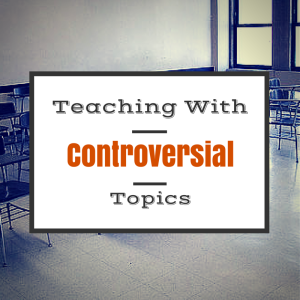 The purpose of an education is to create functioning members of society. It is not about what the author meant when he said this, or what degree of angle is this if the other two are this and that. It is about being able to identify a problem and solve it. Sometimes problems can be solved individually and other times a problem must be solved together. One of the most challenging concepts to teach is how to work together to solve a problem while identifying and respecting another person’s opinion. Here is how I approach controversial topics in the classroom.
The purpose of an education is to create functioning members of society. It is not about what the author meant when he said this, or what degree of angle is this if the other two are this and that. It is about being able to identify a problem and solve it. Sometimes problems can be solved individually and other times a problem must be solved together. One of the most challenging concepts to teach is how to work together to solve a problem while identifying and respecting another person’s opinion. Here is how I approach controversial topics in the classroom.
Teenagers are passionate creatures, don’t let the iPhones and past noon sleep -ins fool you. They are young adults trying to find their own way of doing things and what they believe. They have been told what do think by their parents their entire life and some of it took and other things, not so much. One of my favorite units in English III is the research paper. I hear you groaning, you sound just like my students at first. I let them choose their topic. Whatever they want because research is about the process, not the topic. As a result I have read about everything from the over diagnoses of ADHD in children to why Kobe Bryant is the best player in the NBA. Now my AP students must choose from a list of controversial topics because on the AP English Language exam there is a topic of high interest, and students are given very limited (the most is a brief paragraph) information on a topic and must formulate an opinion about it, but my regular students do the same project just a little modified.
Students research their topic and give three reasons why their opinion is correct. They use books and internet sources while completing annotated bibliographies. They are excited because they are reading about what they love. Now I do require them to include a counter argument in their paper and actually counter it. Besides the paper, they are required to do a powerpoint presentation in front of the class. They take questions from their classmates and myself. How do I get a classroom of thirty-three teenagers do discuss a topic like the death penalty without a riot? The trick is to work backwards.
From the beginning, you must develop an atmosphere of respect. Students need to feel safe in your classroom. They need to know that any idea is welcomed and they will be protected from mockery and insults. I start with anticipation guides. I have controversial ideas that stem from the story or play we read. Students write their own opinion about each of these ideas. I read the opinions and write a question and they usually come up to me later and explain or answer my question. Once a student sees you are genuinely interested in their thoughts and feelings a new level of respect arises. When I feel they are ready, I introduce the fish bowl.
For example, after reading The Crucible: True or False: It is okay to lie if you do it to protect someone. Now they will all try to voice their opinion, but I make them write it down. They also jot down lines and page numbers that support what they think. Then I form a fish bowl. This is four desks in the center of the class and a circle with the remaining desks.
Only the students in the middle are allowed to speak. Everyone else can only listen. Since this is just the beginning of the year, statements made must be backed up by the text. Of course they have completed packets with loads of textual evidence to make this process easier, but everyone has a book and can find more evidence to support what he or she thinks.
Within the fish bowl, if Mary says, “Elizabeth Proctor lied to protect John because she loved him- look on pg. 134.” Everyone in the room must turn to that page. Then John might say, “No, Mary really she did it to protect herself, she was embarrassed John cheated on her, p. 105.” Nia might respond with “I agree with Mary, that she did it to protect John, but I don’t think she loved him. Look at what she said on p. 120.” Once a student has said all he or she has had to say, she may leave the “fish bowl’ and another student can join the inner circle. Students are backing responses with textual evidence. (A common core standard) and the environment is controlled since only four students can speak at a time. Once the first topic has run its course, choose four more students and move on to the next topic.
Once the fish bowl is mastered, we usually can discuss topics as a class. Textual evidence is used without me having to say so. Sometimes we get off topic and it leads to real world issues, especially when we enter the civil war unit. But by this time students understand the purpose of a whole class discussion. They understand that it is okay to disagree with others and still have their own thoughts and opinions. So we move to a controversial topic such as “Why we should drill more in Alaska” or “Why fiction should outweigh nonfiction in the English classroom,” they know what is expected out of them.
I know what you are thinking, you can only do this is you teach at a private school or a “prime real estate” school. No. I teach a low income school with 50% of the kids are on free or reduced lunch. All students want the opportunity to discuss how they feel. The key is teaching them respect and what is tolerated and not tolerated. Sometime we never get passed the “write your own opinion stage” on the anticipation guide. But I respond each on and try to include thought provoking questions. So even if the conversations are just between us, they are there. Some classes only can handle the fish bowl and that is okay too. I love when we can sit together and discuss great ideas and back them up with articles and research. One of my best memories of a class discussion was when a student who claimed that he hated English said: “ ‘According to this article, 54% athletes have been injured’ and that is why they should be paid,” it was one of the proudest moments I have ever had. That is a lesson that stays with them.
Students have researched and proven a hypothesis, they have defended their own thoughts and considered others. This is what education is about. So number 1: Teach and demand respect. 2. Scaffold. 3. Give it a chance. They may surprise you. They have more to offer than we give them credit for. How can they be functioning members of society unless we give them a chance to be?




